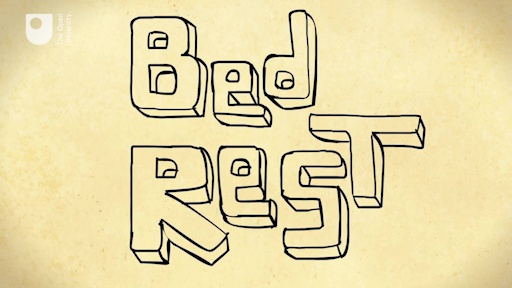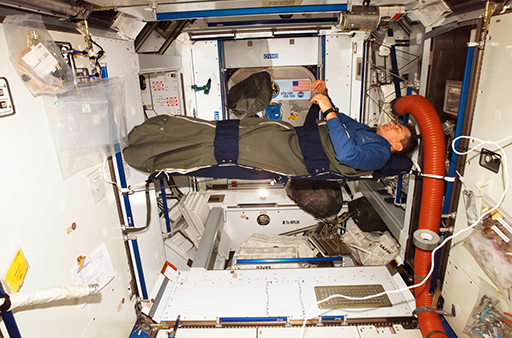3 Bed rest and ageing
It turns out that if you spend a lot of time in bed (even more than a teenager!), your body ages faster than usual. Is this because of inactivity or the act of lying down? Standing up and walking around obviously makes the human body work against gravity, which puts the joints, muscles and bones under stress. Lying down clearly doesn’t put the same parts of the human body under stress.
You can simulate the effects of being in a microgravity environment by using the ‘bed rest’ model, as shown in Video 1. Watch the video and then complete Activity 3.

Transcript: Video 1 The ‘bed rest’ model.
Activity 3 Bed rest in a microgravity environment
Choose the one correct answer to each of the following questions, based on Video 1.
a.
drop
b.
increase
c.
stay the same
d.
disappear
e.
accelerate
The correct answer is a.
a.
poorly
b.
not as hard
c.
harder
d.
faster and faster
e.
unchanged
The correct answer is b.
a.
temporarily affected
b.
more short-sighted
c.
more long-sighted
d.
permanently damaged
e.
unchanged
The correct answer is d.
In the case of the ISS, remember that the astronauts circle the Earth travelling at 28 000 km/h. This means that they will circle the Earth once every 90 minutes and will see up to 16 sunrises and sunsets during a 24-hour period. Also, there is no ‘up’ or ‘down’. So, can you imagine trying to sleep on the ISS (Figure 4)?
Obviously, on Earth you are used to seeing one sunrise and one sunset in a 24-hour period. This means that astronauts have significant changes in their sleep patterns. Their so-called ‘body clocks’ are seriously disturbed.
This disturbance to a sleep pattern also happens to ageing patients. If you don’t get enough sleep, you are less alert during the day. It becomes a vicious circle of tiredness and disturbed sleep patterns, which can seriously affect your overall health. Researchers have found that using a very bright light can reset the ‘body clock’ by copying the effects of sunrise. This approach was originally developed to help ageing people on Earth but has since been adapted to help astronauts preparing for living in space.
As astronauts may have to travel huge distances in future space travel, this will affect their ageing process. Scientists, and writers of science fiction, have often considered how to offset these effects. One option is to place the astronauts into a long sleep whilst they are travelling and then wake them up at their destination. If they had stayed awake the whole journey then they could have aged more when compared with a fellow astronaut placed into a hypersleep state.
Video 1 also mentions long-distance space travel. You might have seen science fiction films which use the concept of ‘hypersleep’ to deal with travelling astronomical distances. In fact, back in 1968 the famous film director Stanley Kubrick (1928–1999) introduced ‘hypersleep’ into popular culture, as well as reinforcing the importance of exercise. This was even more amazing, and showed incredible foresight, when you consider that his film was finished a year before Apollo 11 landed on the Moon in 1969.
All this just shows how an astronaut’s health is affected by living in a microgravity environment. You will now look at other impacts on an astronaut’s general health while in space.

